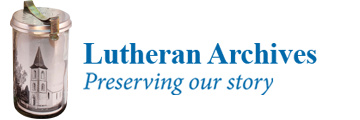First Nations and Mission records
Some of the first Lutherans to migrate to Australia were Lutheran missionaries. Working with First Nations people has been a part of the church’s story since 1838, with missionary work spreading across South Australia, Central Australia, Queensland, New Zealand, and Papua New Guinea.
Lutheran Archives has made it a priority to transcribe records from the German, and to list and describe our mission holdings, in order to facilitate easier access to these records.
Overviews and listings for each mission can be accessed below.
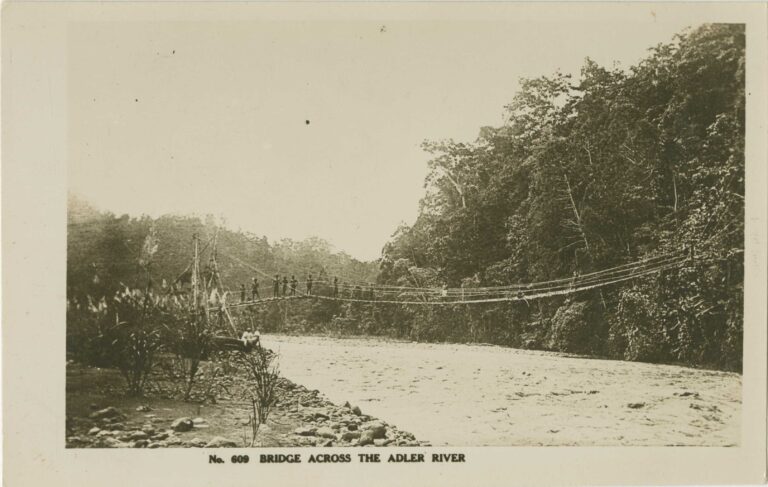
People crossing the Adler River, also known as the Warang, using a swing bridge
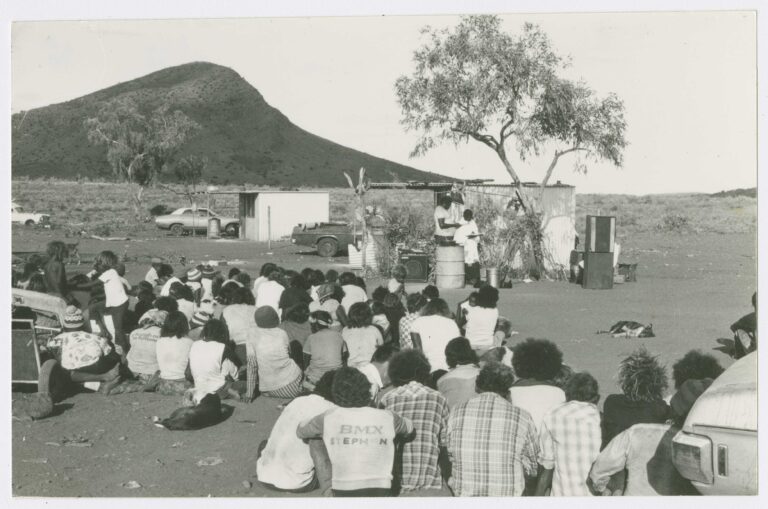
Ascension Day service at Kintore
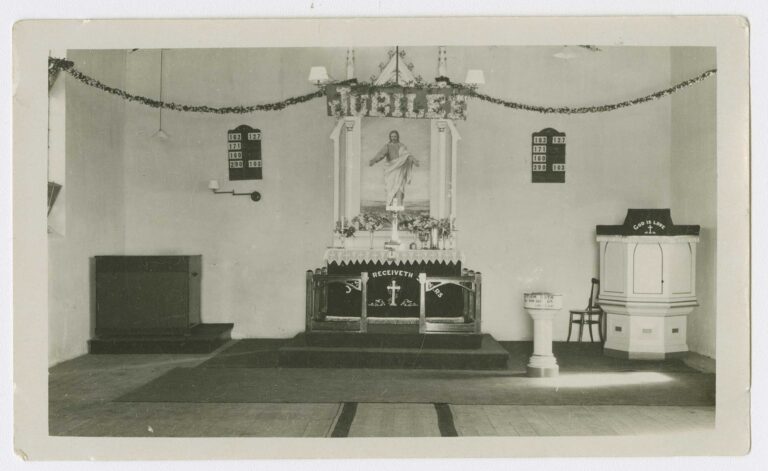
Our Redeemer
The interior of the church at the Jubilee celebration
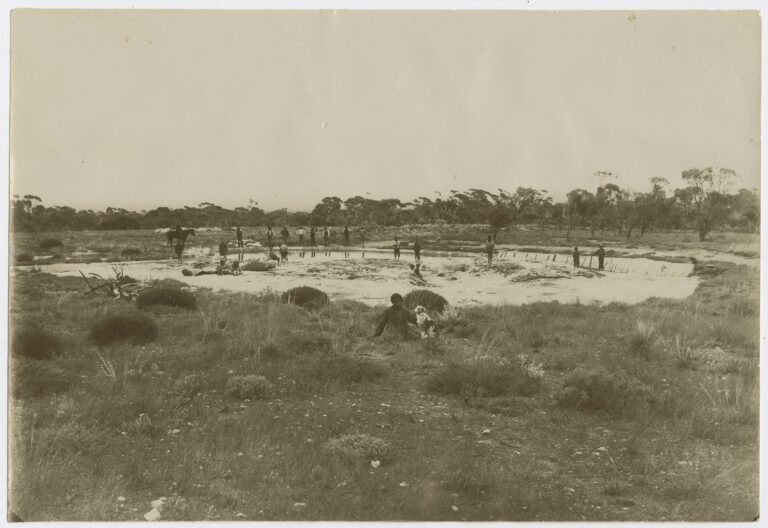
A group of people around the water at a rockhole
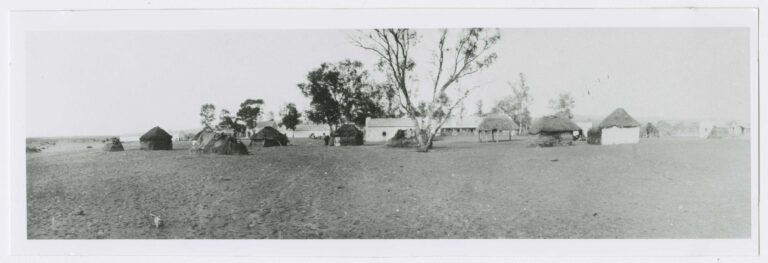
A view of the settlement, Pastor C.F.T. St rehlow's manse is immediately to the right of the tree (in background)
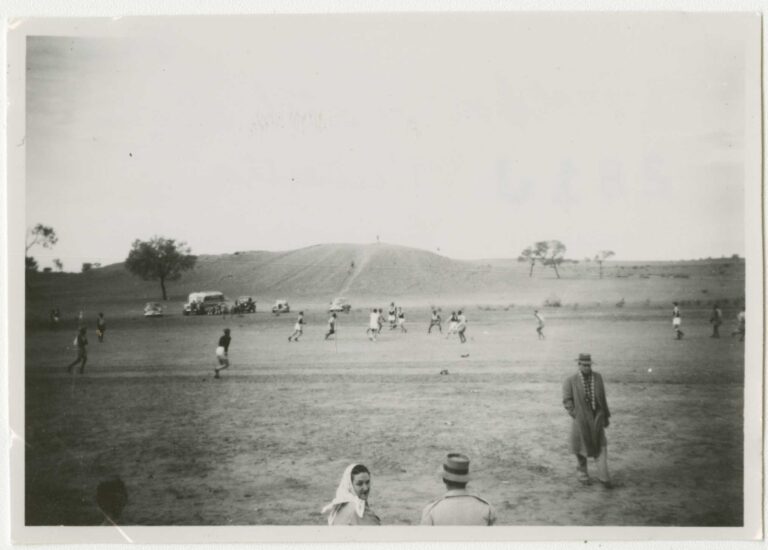
A football match at 'Pututta'.
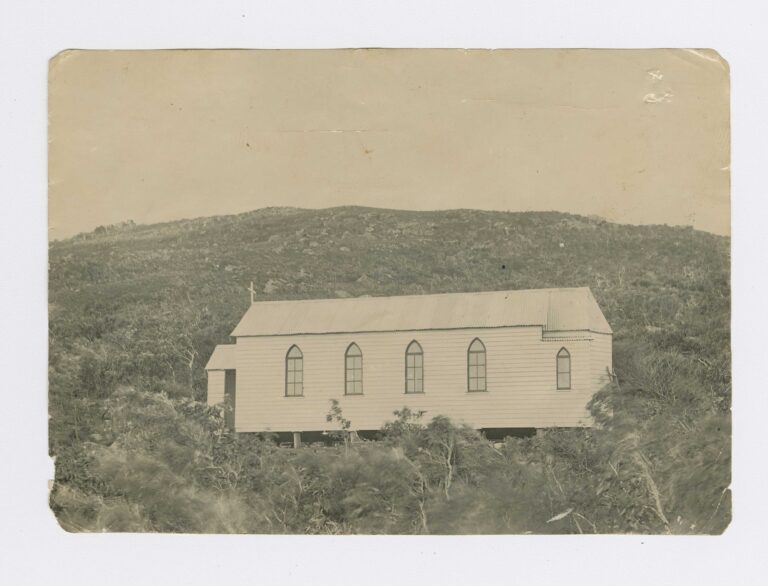
The original church building at Hope Valley
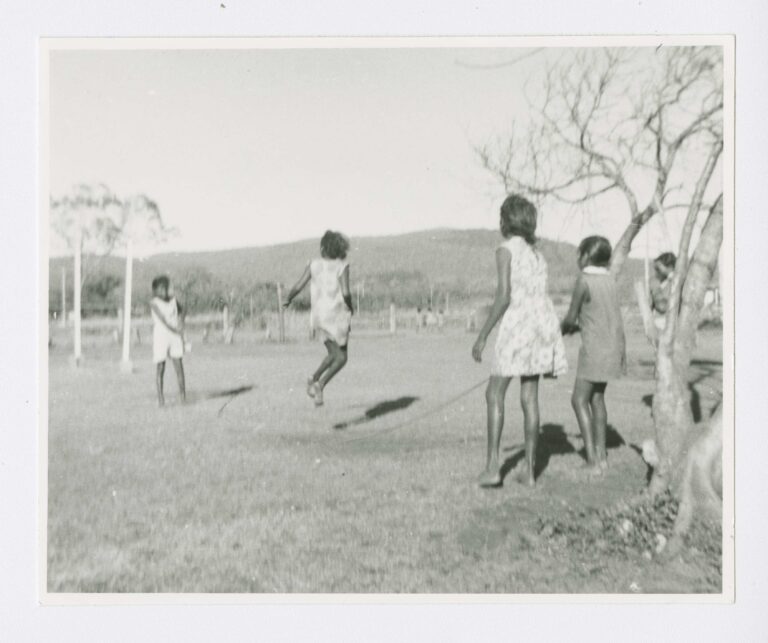
A group of girls playing 'skippy' with a long skipping rope
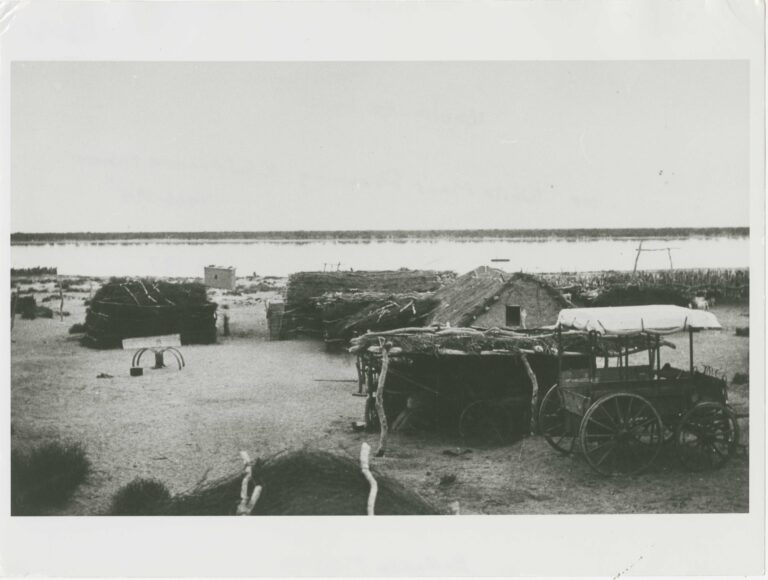
The home of the main missionary at Killalpaninna (the Reuther - Riedel residence).
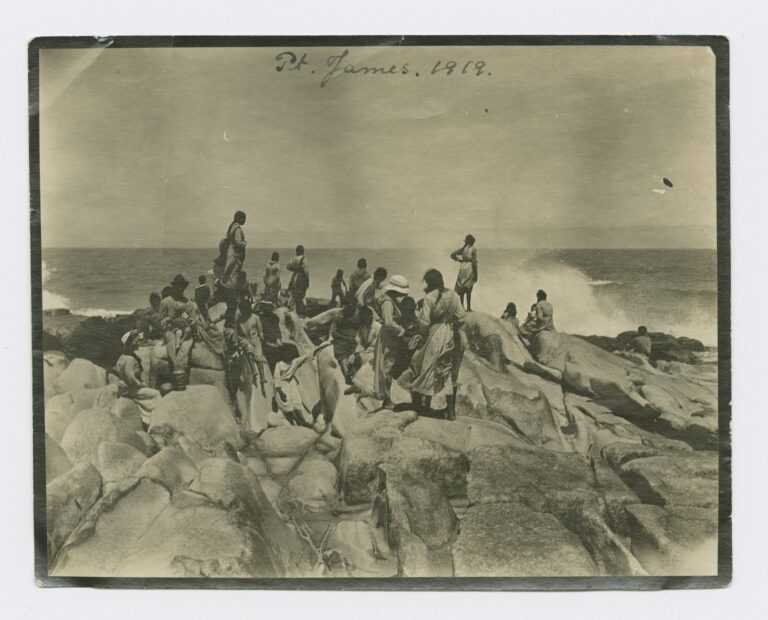
Pt James - 1919
TYPES OF RECORDS
Mission and First Nations records are located throughout many collections at Lutheran Archives. While the synodical collection contains the administrative records of the missions, they also contain Language, family, cultural and school records. First Nations records can also be found in the congregation, AV, photographic, artefacts, book and reference collections. Indexing and captioning these records is an ongoing project.
Visual images from the missions can be searched in Photographs.
Some of our mission records are indexed by name, and these can be searched in Genealogy and Family History.
Some mission records are located in the Personal Papers collection. These are records created by, or about, missionaries and evangelists.
A STORY OF UNITY
The history of the Lutheran church has been peppered with a diverse number of synods and fractures within those synods. Yet missions have been a uniting thread throughout the LCANZ story. Confederations and confessional unions occurred in the 19th century where multiple synods worked together for the purpose of ministering to First Nations People. In 1921, 6 separate synods joined together to form the United Evangelical Lutheran Church of Australia (UELCA) – the primary reason for this amalgamation was to undertake mission work in Papua New Guinea.
You can read more about the diversity of the LCANZ story in Synod & Department Records.
ACCESS
Historical records of the missions are generally accessible to the public. These include synod reports, mission committee minutes, administrative correspondence, education records, language records, publications, missionary diaries and more.
Records that contain personal or culturally sensitive information are not accessible to the general public.
Genealogical records as found in baptisms, marriages, burials are restricted to the general public for 40 years after creation, but are available to those whose records they are – please contact us directly for access to your individual record.
language
A central principle of Lutheran mission work, dating back to Martin Luther’s translation of the Bible into German, is that everyone should have the opportunity to read the Bible and practice the Christian faith in their own language. Lutheran missionaries learned and recorded Indigenous Languages from the moment of first contact, so that they could teach the key concepts of the Christian faith in the mother tongue of their hearers.
The Language records produced by Lutheran missionaries and First Nations knowledge-holders have been used extensively in modern Language reawakening efforts.
lutheran missions
Place: Pirltawardli (bank of River Torrens, North Adelaide)
People: Kaurna
Language: Kaurna
Mission oversight: SA Government and Dresden Mission Society
In 1838, Clamor Wilhelm Schürmann and Christian Gottlob Teichelmann, of Dresden Mission Society, arrived in the colony of South Australia to commence mission work among the Kaurna people. The two missionaries, the first sent out from the new mission house, were sponsored by George Fife Angas. A school was established in 1839 in which European subjects including English were taught, and a new mission was established at Encounter Bay with Schürmann. In 1840, the Dresden Mission Society sent missionaries Heinrich August Eduard Meyer and Samuel Gottlieb Klose to work with Schürmann at Encounter Bay and Teichelmann at Adelaide respectively.
Teichelmann and Klose remained working with Kaurna People at Pirltawardli until the mission and school were closed through the actions of Governor Grey in 1845. Teichelmann had attempted a relocation of the mission from 1843-1845 to a farm at Happy Valley, south of Adelaide, but this failed. Klose continued as a teacher at the new government Native Establishment School for a year before Teichelmann and Klose began the Trinity Congregation in Adelaide. As the Kaurna people were pressured to leave or forcibly removed from the Adelaide area, in 1848 the four missionaries requested the Dresden Missionary Society to release them.
Place: Ramong (Encounter Bay)
People: Ramindjeri
Language: Ngarrindjeri
Mission oversight: SA Government and Dresden Mission Society
In 1839 Clamor Schürmann was approached by Governor Gawler to begin a mission at Encounter Bay, leading to the Dresden Mission Society sending two more missionaries to support them at the two mission sites, Adelaide and Encounter Bay.
Schürmann left in 1840 to take up a position in Port Lincoln as Deputy Protector of Aborigines and Heinrich August Eduard Meyer took over the running of the Encounter Bay mission.
The Dresden missionaries had a vision of establishing self-supporting agricultural missions, but failed to appreciate the local Indigenous peoples seasonal and cultural movements, and the greater wages offered at the south coast whaling stations. This led Meyer to suggest that South Australia should have been left to the English churches as they had a moral responsibility for the spiritual welfare of those they had dispossessed.
While Meyer maintained cordial relations with the local Ramindjeri people, the collapse of the whaling industry and withdrawal of government support in 1846 saw the majority of them leave the area where the mission had been granted land. Schürmann briefly joined Meyer in 1846 to assist in the running of the school and undertaking mission fieldwork, but the mandate from the DMS that the missions should be self sustaining led the four missionaries to request release from their calling as missionaries and the Encounter Bay mission closed in 1848.
Place: Galinyala (Port Lincoln)
People: Barngarla
Language: Barngarla
Mission oversight: SA Government and Dresden Mission Society
In 1840 Clamor Schürmann was offered the post of Deputy Protector of Aborigines at Port Lincoln and took the post, leaving the newly arrived Meyer to run the Encounter Bay Mission.
As well as the government work, Schürmann attempted mission work with the Barngarla, but was hampered by his lack of knowledge of the language, and general disinterest from the Barngarla.
In 1843 Schürmann started farming at Proper Bay and encouraged Barngarla men to assist him, using government rations as wages, but by 1845 he had returned to Adelaide, having decided that mission work should focus on Adelaide and Encounter Bay.
After two years working with Meyer at Encounter Bay, Schürmann returned to Port Lincoln as the Government translator. In 1850 he set up a school and farm at North Shields where he instructed in the Barngarla language, but within a few months an Anglican mission was established at Poonindie, just 5 kilometres away. In 1852, when Schürmann’s government employment was terminated, he realised that the government would soon require the two schools to merge under the direction of the Church of England, so he gave up the school and returned to Adelaide.
Place: Maree, Killalpaninna
People: Dieri
Language: Dieri
Mission oversight: Evangelical Lutheran Synod in Australia
In 1865, Pastor Ludwig Harms, head of the Hermannsburg Mission Society in Germany, partnered with the South Australian Lutheran synods to establish a mission in the North-Eastern area of the colony. A year later, German missionaries J.F. Gössling and E. Homann, with lay helpers H.H. Vogelsang and J.E. Jacob, left Tanunda in the Barossa Valley for Lake Hope. From Lake Hope, they decided to relocate to Lake Kopperamanna to join a group of Moravian missionaries who had arrived earlier, before moving further west again. After a drought-laden three month journey, they established their mission at Lake Killalpaninna. This area was an important Dieri ceremonial and trade centre where large gatherings of neighbouring language groups met periodically.
Over the next 12 years, the mission struggled to settle from conflicts with Dieri communities, drought and flood, and internal politics. J. Flierl and teacher C. Meyer replaced Gössling and Homann, and baptisms and services began in 1879. In 1888, missionary J. G. Reuther arrived, and with missionary and anthropologist Carl Strehlow (1892-1906) translated Lutheran works into the Dieri Language, as well as documenting Dieri grammar and vocabulary. Missionary J. Reidel replaced Reuther in 1908.
Continued financial and political issues meant that by 1910, the population of the Mission had shrunk to approximately 130 people. The mission station was sold to two Lutheran pastoralists in 1914 on the proviso that they continue to teach and care for the Aboriginal population. A lay missionary remained at the station to run the school, where seventy Aboriginal children remained.
After the outbreak of World War I, and the South Australian Royal Commission on the Aborigines recommendation that the mission be taken over by the government, the mission was closed in 1915, becoming an ordinary station. The Aboriginal population returned to more traditional lifestyles at local camps, while a small number stayed on to work at the station. The school continued to operate until 1917 when the government closed all Lutheran schools.
Place: Ntaria (Hermannsburg), Mparntwe (Alice Springs)
People: Arrernte, Western Arrernte
Language: Arrernte, Western Arrernte
Mission oversight: Evangelical Lutheran Synod in Australia/Evangelical Lutheran Immanuel Synod in Australia/United Evangelical Lutheran Church in Australia/Lutheran Church of Australia
Hermannsburg was established at a sacred site known as Ntaria, associated with the Arrernte ratapa dreaming. Missionaries A. H. Kempe and W. F. Schwarz of the Hermannsburg Mission from Germany travelled overland from Bethany in the Barossa Valley, South Australia, and set up Hermannsburg in 1877. By 1880 a church was constructed and the first service took place on 12 November, followed by school on 14 November. The first Aboriginal baptisms took place in 1887.
Schwartz left the mission in 1889 due to ill health. Kempe lost his wife and child during childbirth and was himself suffering from typhoid, so also left the mission in 1891. The settlement was continued by lay workers until pastor Carl Strehlow arrived in 1894 with his wife, Frieda. A School House was built at the Mission in 1896. Children were rewarded for attending school via the distribution of rations.
The Strehlows returned to Germany for a break in 1910. While they were away, they were replaced by Leibler and H. H. Heinrich. Carl, Frieda, and their son Theo (Ted) returned in 1912. The Strehlows left in 1922 when Pastor Strehlow became gravely unwell. He died on the journey to Adelaide at Horseshoe Bend.
Missionary J. Riedel arrived in 1923, followed by Pastor F. W. Albrecht and his wife Minna in 1926. Albrecht was integral to the development of the Kuprilya Springs Pipeline, which piped water from a permanent water hole 6 km to the mission, completed in 1935. They also supported the development of the school of watercolour landscape artists, which became one of the special heritages of the Hermannsburg area. The Albrechts stayed until 1962.
The ‘Mission Block’, also called the Children’s Cottages, was built in 1938 in Mparntwe (Alice Springs) – many children from Hermannsburg were sent there to attend school. The Mission Block closed in 1982. The first two Aboriginal pastors, Conrad Rabaraba and Cyril Motna, were ordained in 1964. Over the time of the mission, services and pastoral acts have been performed at outposts such as Papunya, Haasts Bluff and Areyonga.
The mission land was handed over to the Traditional Owners in 1982 under the Aboriginal Land Rights Act 1976. The heritage precinct is owned by the local Western Arrernte people, represented by the Hermannsburg Historical Society, while the Finke River Mission act as managers.
Places: Cape Bedford
Languages: Guugu Yimithirr
People: Thubi Warra, Guugu Yimithirr
Mission oversight: Neuendettelsau Mission Society/Evangelical Lutheran Immanuel Synod in Australia
In 1885, Missionary Johann Flierl, while in Cooktown, negotiated with the Queensland Government to establish a mission close to Cooktown at Cape Bedford, on the land previously been gazetted as an Aboriginal reserve in 1881 – this mission was known as Elim. He also negotiated the establishment of the Bloomfield mission. Flierl left the mission in 1887 and was replaced by George Schwartz, who remained at the mission for more than 50 years and was called ‘Muni’ by the residents at Hope Vale.
Schwartz established a second site for the mission in December 1887, which he called Hope Valley. For 13 years the mission operated out of both locations and in 1900, Schwartz closed down Elim and consolidated the mission at Hope Valley. In 1902 the Mari Yamba Lutheran mission near Proserpine was closed and its residents transferred to Hope Valley. In 1909 the reserve area was extended to include land along the McIvor River. Schwartz established the Wayarego outstation on the McIvor River about 1911. In 1914, the mission was again moved, this time to Spring Hill at the southern end of the reserve area. By 1934 the size of the reserve was 225,300 acres and included Mt Webb.
During WW2, in 1942, Schwartz came under suspicion by federal forces and was interned on 17 May 1942. The army levelled the mission and the Aboriginal population of over 300 was forcibly removed. While some elderly people were sent to Palm Island from Hope Valley, the majority were taken to Woorabinda, west of Rockhampton and over 1,000 kilometres away. This group, which became known at Woorabinda as the ‘Cape Bedford people’, suffered greatly as a result of this removal and there was a high death rate among the group.
In early 1949, a work party of former residents returned to re-establish the mission which was now to be known as Hope Vale. This new mission was about 25 kilometres from the old Hope Valley Mission. By December 1949 there were 15 houses, a boys’ dormitory, a workshop and a shed erected on the site. The girls’ dormitory was completed soon afterwards. It was gazetted as an Aboriginal reserve in September 1952.
By 1953 Hope Vale had three permanent residences for the staff, a school, store, boys’ and girls’ dormitories, machinery shed and over 50 houses. A new girls’ dormitory was built in 1962, but by January 1968 all dormitories at the Hope Vale Mission closed and the children were placed with either their parents or foster parents.
In 1986 the community received a Deed of Grant in Trust and formed the Hope Vale Aboriginal Council.
View the Hope Vale – Wujal Wujal Collection Finding Aid here.
Place: Wujal Wujal (Bloomfield River)
Language: Kuku-Yalanji
People: Kuku-Yalanji
Mission oversight: Evangelical Lutheran Immanuel Synod in Australia
Wujal-Wujal mission was established as the Bloomfield Mission in 1886 by Johann Flierl in tandem with the Cape Bedford mission. As with Cape Bedford, Wujal-Wujal came under the auspice of the Immanuel Synod, with missionary Carl A. Meyer overseeing the mission from 1887 to 1891.
1891 saw Johann Sebastian Hörlein, sent straight from Neuendettelsau Mission Society in Germany, replace Meyer. He was joined by colleagues Matthias Bogner and Johann Christian Mack, but by 1901, after much criticism and mismanagement, the mission was closed.
The Hope Valley Mission Board was granted funds to re-establish a reserve on the Bloomfield River in 1957, and the reformed mission was administered by the Hope Vale administration until it was closed in 1986.
View the Hope Vale – Wujal Wujal Collection Finding Aid here.
Place: Gregory River
People: Giya
Language: Giya
Mission oversight: United German-Scandinavian Lutheran Synod of Queensland (UGSLSQ)
Mari Yamba was established by the United German-Scandinavian Lutheran Synod of Queensland (UGSLSQ) which later amalgamated with others to become UELCA. Situated 25 miles south of Proserpine on the Andromache River and covering 78 square kilometres, the mission reserve was the result of a government land grant in February 1888.
Andreas Christian Claussen, a Hermannsburg (Germany) graduate, chose the site and was the head of the mission, supported by Martin Doblies. However, within a short time the two clashed, and Doblies was dismissed. After another five years of administrative, relationship and financial struggles the Claussens left for Toowoomba in 1893.
By 1901 the mission was in dire financial crisis. The mission had gone through a string of missionaries and faced grievances from local communities and government. In 1902 the mission closed and the Mari Yamba mission residents were removed to Cape Bedford Mission.
Place: Koonibba
People: Wirangu, Mirning, Kokatha
Languages: Wirangu, Mirniny, Kokotha
Mission oversight: Evangelical Lutheran Synod/Church of Australia
In 1899, the Lutheran Church in South Australia purchased 16,000 acres of land to the west of Ceduna and established the Koonibba Mission in 1901. Schooling and religious services for the local Aboriginal population began almost immediately and a dedicated schoolroom for local Aboriginal children was built within the first year of the mission’s operation. It was not until 1903 that the church itself was erected, built by Thomas Richards and Mickey Free (Michael Free Lawrie), two Aboriginal men. The Koonibba Football Club was formed in 1906 and is the oldest Indigenous football club still in existence, competing in the Far West Football League today.
Many Aboriginal people in the area moved to or travelled regularly to the Mission, seeking work, rations, or to visit nearby ceremonial grounds. People were encouraged to stay through the message of the Gospels, but also paid work, rations, and better food and housing. The Koonibba Children’s Home was opened in 1914.
August Bernhard Carl Hoff was Superintendent of the Mission from 1920 to 1930, and between 1920 and 1952 compiled a wordlist from the Wirangu, Kokatha and Pitjantjatjara languages, subsequently published by his son Lothar in 2004.
In 1931 the decision was made to sell the station, and the residents petitioned the Church to work the land autonomously, to no avail. No buyers were forthcoming, and farming ceased in 1933, leading to the 1958 walk-off in protest of church control. In 1963, the school was closed and the Mission was taken over by the South Australian Government as an Aboriginal reserve. In 1975 control of the Koonibba Mission was handed to the Koonibba Aboriginal Community Council, and the land was purchased by the Aboriginal Community in 1988.
In 1843, Lutheran missionaries Johann Baucke and Johann Engst landed on the north coast of Chatham Island, an archipelago roughly 800kms east of New Zealand’s South Island, in the hopes of establishing a Lutheran mission to the Moriari and Maori residents on the islands. Although the mission was not successful, the Baucke family stayed on the island for some years, and the building is still standing today.
At the same time, German migrants were settling in The Upper Moutere area, near Nelson, from about 1843. Four Lutheran missionaries accompanied them, sponsored by the North German Mission Society and led by J.C. Riemenschneider. One of the missionaries, Johann Wohlers, soon left to work among Māori on Ruapuke Island, near Stewart Island. Pastor Riemenschneider moved to Taranaki and set up the first North Island Lutheran mission. Pastor Johannes Heine remained in Nelson, where 4% of the population was Lutheran in 1861.
Friedrich Karl Gottlieb Blaess was another missionary who came to work in Aotearoa. He arrived in 1893, and served at Normanby and Pungarehu mission stations in the Taranaki region until 1906, when the mission was closed. You can read about Blaess’s records at Lutheran Archives in the Personal Papers series.
Lutheran mission work in New Guinea and surrounding islands began with the arrival on 12 July 1886 of the German missionary Johann Flierl. Flierl travelled to New Guinea via Australia where he initiated missions in central and far north Queensland, and met and married Louise Auricht. Together, they established the strong Lutheran mission presence in today’s Papua New Guinea, with missionaries serving from different Australian and American synods and German mission houses.
After World War 2, the Evangelical Lutheran Church of Australia requested The Lutheran Church—Missouri Synod (LCMS) assist with mission outreach in unreached parts of Papua and New Guinea, and to generally rebuild mission work in the islands. The LCMS responded positively, sending Rev. Dr. Willard Burce and Rev. Dr. Otto Hintze as missionaries in 1948, and cooperating with missionaries Rev. Harold Freund and Patrick Kleinig from Australia.
Since then, Australian Lutherans have been involved in a vast range of mission roles including pastors, teachers, deaconesses, mechanics, pilots, doctors, nurses, secretaries, accountants, builders, and many more.
The country of Papua New Guinea obtained its independence from Australia in 1975 and the now autonomous Lutheran Church was recognised as the Evangelical Lutheran Church of Papua New Guinea (ELCPNG) in 1976. Papua New Guinea saw great economic and cultural changes following independence, as the new government began to shed its colonial past, leaders and workforce. ELCPNG felt that they no longer needed as many missionaries from overseas. This decline in the need for missionaries in PNG also coincided with a movement within the LCA for a greater focus on mission at home. Gradually the number of missionaries sent to PNG began to decline, with only a handful of Lutheran mission workers now working in PNG.
